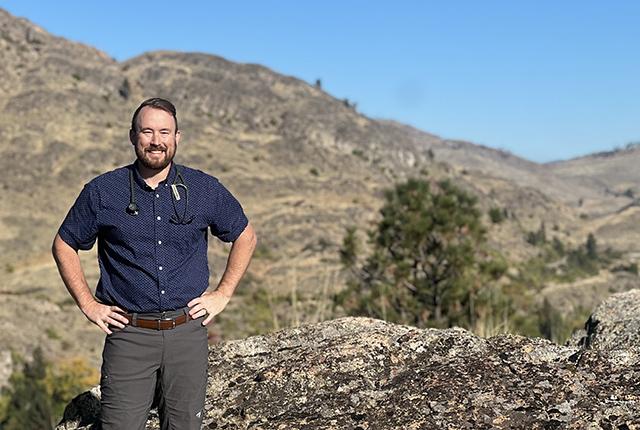
Rural training makes docs more open to rural practices
A Chelan doc exemplifies a study showing that medical residents who receive rural training are more likely to practice rurally.Media Contact: Barbara Clements - 253-740-5043, bac60@uw.edu
As a child, each summer and each Christmas, Andrew Gray would take a pilgrimage from the Seattle suburbs to hang out with his grandparents in Colville, Eastern Washington. Over time, and as he witnessed the community’s regard for his grandfather, he grew curious about what it meant to be a country doctor.
During the summers, Dr. Edmund Gray would fix broken legs and scraped knees. He made house calls and was chatted up at the grocery store and the gas station. “Every time on Christmas Eve services there, people would make a point of coming up and saying hello to him,” Andrew Gray recalled.
“I realized he was important to this community,” says Gray, who today is a physician, too.
Around 2017, when he was considering what area of medicine to focus on, Gray first leaned toward surgery but ultimately decided on family medicine. During a three-year residency at the University of Washington School of Medicine, he did the bulk of his training in Chelan County.
That was all Gray needed to believe that rural medicine was his calling.
“That rotation cemented me into what I want to do. I just loved having the impact on the lives around me that family medicine provides,” said Gray, a practitioner at Columbia Valley Community Health in Chelan.
His day might include a 24-hour ER shift, delivering a baby, setting a broken leg or doing a colonoscopy.
Gray’s decision to put down rural roots aligns with the findings of a study published this year. The landmark research involved 3,694 recent residency graduates who were surveyed and followed from 2016 to 2018.
Among family medicine doctors, the researchers found that almost half, 43%, of those who were raised in urban areas but who did their residency in rural areas decided to locate their practices in rural settings. Among urban-area residents who did not complete a rural rotation, the likelihood of subsequently opting for a rural practice dropped to 12.5%.
Those findings might be key to filling the greatly underserved medical needs of rural America, according to the study’s lead author, Davis Patterson. He’s a research associate professor in family medicine at the University of Washington School of Medicine. He directs the Rural Health Research Center within the school’s WWAMI program (Washington, Wyoming, Alaska, Montana, Idaho).
“We definitely need to invest in rural students,” Patterson said. “We need to get health professionals in family medicine. But if you train urban students in a rural place, they are more likely to engage in rural practice than rural students who train in an urban place.”
According to a report published in June by the U.S. Health Resources and Services Administration, 65% of rural areas have a shortage of primary care physicians. Approximately 15% of the U.S. population lives in rural areas, but only 10% of practicing doctors are in these communities, according to the Centers for Disease Control and Prevention and the American Hospital Association.
The gap is clear, Patterson said.
“We need to train everyone, both those residents from rural and urban areas, in rural residencies. In addition, we need more rural areas to establish residencies, and longer residencies” than the typical 18-month rotation.
“I think if you encourage rural training, it will go a long way to helping fill the physician shortage in rural areas,” he said.
In the bigger picture, it’s addressing a matter of healthcare equity for these parts of our nation, he added said. “We do not have enough rural residency programs to fill this need.”
Andrew Gray agreed.
“The way to change this is to expand the programs in rural areas for all types of medical providers,” he said. “By creating and fostering training environments that physically places learning physicians in rural areas, it not only fills the major access gaps existing in our rural communities, but also exposes and promotes the partnership between physicians and the communities they serve.”
For details about UW Medicine, please visit http://uwmedicine.org/about.
